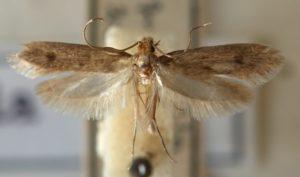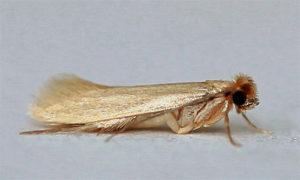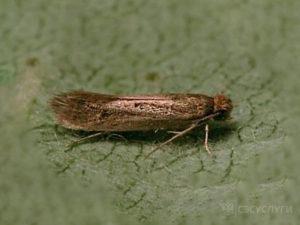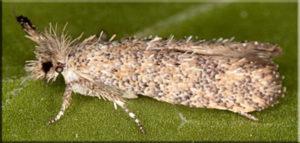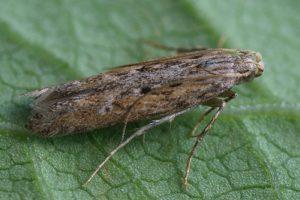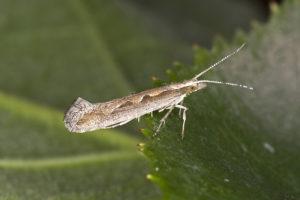Types of moths - an insect that turns from a nondescript butterfly into a pest
Every person in his life encounters a moth, and many people know what a moth looks like. This gray colorless pest does not look dangerous, but first impressions can be deceiving. To better know how to get rid of insects and prevent their appearance in the house, you need to recognize the enemy in person, starting with his description and characteristics.
Content
What you need to know about moths
Depending on the type of moth, its taste preferences change. There are individuals that prefer to eat groceries, others fruits, others potatoes or nuts. There are pests that spoil grain stocks or love fur coats.
But they never change their preferences. The barn moth that eats grain will not fly into the house to covet a fur coat.
General characteristics
The moth looks like a small brownish-yellow, gray or white butterfly with silvery pollen on its wings. It lives mainly in dark, inaccessible places for sunlight. For example, in closets, pantries.
The larvae hatched from eggs prefer to be in the dark, where it is difficult to see them. It is the larvae that do the most harm. They eat as much as it takes to turn into a butterfly.
Features of reproduction
A mole goes through the following stages during its life:
- The butterfly lays eggs, from which larvae appear, which pupate, and butterflies emerge from them. For things, the larvae that appear from the eggs laid by the butterfly in the fibers of fabric or fur are dangerous. It is important to know that in a city apartment, an insect is able to lay eggs all year round.
- The egg develops for two weeks at a temperature of +20 degrees, the period of development of the larva is from three to ten months, at which time it forms a cocoon around itself from the material in which the larva is wound up.
- After leaving the cocoon, the butterfly lives for 2-4 weeks, it flies mainly at night, but poorly, because its wings are poorly developed. Throughout her life, she lays eggs.
Moth species
To date, many types of moths are known that live in cabinets, in beds or warehouses. Although they live in different places, they cause equally great harm.
Popular species living in the house
There are several subspecies of what types of moths are. They have differences in terms of life, size and external features. Most often, typical methods that act in the same way help to deal with them.
fur moth
Butterfly coat moth with shiny wings, they are dark yellow on top, the bottom layer is light gray. Its wingspan is 14-15 mm.
The fur coat pest feeds on clothes made from natural materials.
Its larvae look like white caterpillars, almost transparent, so that the contents of the stomach can be seen through their skin, there are eight short legs on the abdomen. The larvae feed on fur products, prefer arctic fox and mink.
Clothes moth
In this species, the wings at the base have a purple hue, towards the middle they become yellowish and there are small brown spots at the end of the wings. Wingspan at dress butterfly up to 22 mm.
Its larva is covered with white fluff and looks like a larva of a fur coat variety. It is in the folds or inside the woolen fabric and imperceptibly eats large areas of the product. On clothes, it is held with a fixed cover.
furniture moth
Furniture moth butterfly with shiny silver-yellow wings, dark yellow head, wings at the base with a brown tint. It differs from other varieties of moths in the absence of oral tentacles.
First, the furniture larva eats the hair stuffing in the soft parts, then, closer to the pupation period, it begins to gnaw tunnels in the hard parts of the furniture. Pupation occurs under chairs, sofas, armchairs, there are many white cocoons.
In winter, the larvae develop for 5 months, in summer it happens faster - about 2 months.
Agricultural pests
The pest causes great damage to grain crops such as wheat, barley, oats, and rye. There are two types: grain and rye. Even a small number of moths, if not destroyed in a timely manner, can ruin large stocks.
grain moth
This species is silver-white in color with a bright brown pattern on the wings, its abdomen is gray in color. Wingspan up to 15 mm. breeds grain moth mostly in spring and summer. You can meet it most often in places of storage of grain crops.
The female lays up to a hundred eggs directly on the grain, sticking one or two eggs to each grain. It combines several grains with a sticky liquid that looks like a web. The female is inside this lump and feeds on grains; in order to move around, she needs to carry the entire bunch along with her.
The grain species pupates in the cracks of the floor or walls. It also feeds on dried fruits and plant seeds.
rye moth
Rye has dark yellow hindwings with a brown edging. Its wingspan is up to 13 mm. It is distributed mainly in central Russia.
Eggs are laid at the end of summer on emerging winter crops and wild cereals. The parasite eats away the core of the stem and hibernates in it, the larvae pupate closer to the middle of summer.
Potato moth
Its very name says that this pest infects potatoes. It looks unattractive, the wings are dirty gray with dark spots. Its larvae are light green or pink in color. The hatched has long whiskers and a body with folded wings up to 7 mm. lives potato moth just a few days. Her appearance helps to remain almost invisible. The eggs of the female are laid on the lower part of the leaves, the hatched larvae grow very quickly.
Suffer from parasites planting potatoes. This subspecies can withstand temperatures up to +4 degrees, does not die. Some parasites get into potato tubers and survive the winter in places of storage. In the spring, they again fall into the soil when potatoes are planted.
Cabbage moth
This species harms plants from the cruciferous genus. Appearance cabbage moth differs from other species: the body is light green in color with small villi, the wings are fringed along the edges. The larvae have brown heads.
The cabbage individual flies poorly, does not move far from its cocoon, one or two individuals can be seen on the leaf, they rarely gather in groups. The eggs are green, almost invisible on the leaves.
food moth
This moth harms the stocks of cereals, the storage conditions of which are not met. inhabits food moth and in the wild, steppes or forest-steppe, eating nuts or fruits.
The color of the moth is discreet, the body length with folded wings is up to 8 mm. The caterpillar is pink or light yellow in color and has a smooth body. Ideal conditions for development are a temperature of +25 degrees and a humidity of 50%. All stages of development take more than 1,5 months. This is due to the fact that this subspecies has large food reserves.
Chestnut moth
Harms chestnut and maple leaves. Chestnut moth spends the whole winter in the state of chrysalis, and when it warms up, adults appear. The offspring of the chestnut appears in two weeks and immediately clings to the young foliage.
The defeat leads to shedding of leaves and death of the tree. You can spot the presence of parasites by the orange spots on the leaves. Small wood-colored cocoons can be hung on the underside of the foliage.
Causes of appearance
Depending on the type of insect, the reasons for the appearance will be different, but they can all get into the house from neighbors or from the entrance through open windows or doors. Often it gets inside from the ventilation. If several individuals are wound up with neighbors, then there is a high probability of them getting into apartments lower and higher. At risk are also those located above grocery stores or warehouses.
Ways to get rid
If a mole is wound up in an apartment, there are several ways to get rid of it:
- Special aerosol. This remedy will help if you find the place where it lives and process it. After applying the aerosol, you need to leave the house for several hours, and after returning, do a wet cleaning.
- Velcro or traps for the moth. They are hung in the kitchen or near cabinets, the moth sticks and dies. Often they are simple paper, on a sticky basis, attached to inconspicuous areas of the cabinet.
- Pills. They can be laid out in the expected places of occurrence of moths.
- Folk remedies. These include various repellent formulations of herbs, washing with soap or vinegar.
- To combat agricultural moths indoors, do processing, infected grain is heated or frozen. The room must be disinfected and dry well.
They also process vegetables in which moths are wound up. You can use chemicals or folk methods that last longer and more efficiently.
Any moth does not like strong movements and temperature fluctuations. Therefore, at home, heat treatment helps. Moreover, it tolerates both frosts and heat equally badly.
Preventive measures
There are a number of necessary requirements that will help keep your belongings and products safe and sound.
- When buying products, pay attention to the condition of cereals, flour, dried fruits, herbs.
- Keep food in closed jars or bags soaked in salt water in the house.
- Kitchen cabinets are recommended to be aired frequently and wipe the shelves with vinegar, lay out lavender or orange peels on them.
- Observe the shelf life of products, especially nuts, dried fruits, as moths often start in them.
- Woolen and fur things should be kept clean, any repellents should be laid out in the closet.
- When buying, carefully inspect for damage or moth larvae. Things are important to regularly ventilate and inspect.
- When preventing agricultural moths, the premises are ventilated and treated before storing a new crop.


Watch this video on YouTube
Conclusions
Despite the wide variety of moth species, there are effective methods to deal with it. But more important are preventive measures and compliance with the rules for storing products and things that are at risk.
Modern moths are able to adapt to drugs that are used to combat the parasite. Therefore, it is important to change different means, apply folk methods and, depending on the situation, seek help from specialists.
Previous
